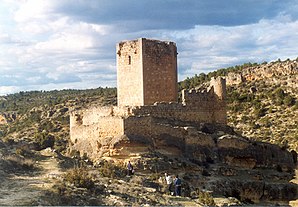Paracuellos
| Paracuellos parish | ||
|---|---|---|
 Paracuellos - Castillo
|
||
| coat of arms | Map of Spain | |
 Help on coat of arms |
|
|
| Basic data | ||
| Autonomous Community : |
|
|
| Province : | Cuenca | |
| Comarca : | Serranía Media | |
| Coordinates | 39 ° 43 ′ N , 1 ° 47 ′ W | |
| Height : | 980 msnm | |
| Area : | 123.48 km² | |
| Residents : | 94 (Jan. 1, 2019) | |
| Population density : | 0.76 inhabitants / km² | |
| Postal code : | 16373 | |
| Municipality number ( INE ): | 16150 | |
| administration | ||
| Website : | Paracuellos | |
Paracuellos is a place and a municipality ( municipio ) with only 94 inhabitants (as of January 1, 2019) in the north of the province of Cuenca in the autonomous region of Castile-La Mancha . The place is located on the Ruta de la Lana , a once important trade and pilgrimage route that - coming from Alicante or Valencia - led to Burgos .
Location and climate
Paracuellos is located in the headwaters of several streams on the west side of the Iberian Mountains at an altitude of approx. 980 m . The provincial capital Cuenca is about 80 km (driving distance) to the northwest. The climate in winter is temperate, while in summer it is warm to hot; the rather low amounts of precipitation (approx. 495 mm / year) fall - with the exception of the almost rainless summer months - distributed over the whole year.
Population development
| year | 1857 | 1900 | 1950 | 2000 | 2019 |
| Residents | 637 | 881 | 751 | 155 | 94 |
Due to the mechanization of agriculture , the abandonment of small farms and the resulting loss of jobs, the population of the municipality has declined sharply since the middle of the 20th century ( rural exodus ).
economy
For centuries the town's economy was largely self-sufficient ; Surplus cheese and sausages as well as animal skins and wool could be sold to traveling traders or exchanged for other products.
history
There are no finds of settlement in the Celtic , Roman , Visigothic and even Islamic-Moorish times. After the recapture ( reconquista ) of the cities of Toledo (1085) and Cuenca (to 1177) and its surrounding region by the troops of the Castilian kings Alfonso VI. and Alfonso VIII a policy of repopulation ( repoblación ) by Christians from all parts of the Iberian Peninsula was pursued. From the 15th or 16th century, the gradual relocation of the village to its current location began.
Attractions
- The Iglesia de Santiago Apóstol , mainly made of rubble stones (mampostería) , is a building from the 17th century with later changes. On the outer walls there are clear traces of an elevation of the church, which suggest a vaulting of the interior. The south portal, protected by a porch, has a straight, classicist frame.
- Surroundings
- In a wooded area about 4 km (footpath) north of the village is the ruin of a former Moorish castle, which is worth seeing, but was almost completely rebuilt by the Christians in the 13th century. The dominant keep (torre del homenaje) built on a square floor plan and a significantly lower corner tower on a round floor plan are striking . The remains of the foundations of the houses in the former village can be seen at its feet.
Web links
- Paracuellos - Photos + Info (Spanish)
Individual evidence
- ↑ Cifras oficiales de población resultantes de la revisión del Padrón municipal a 1 de enero . Population statistics from the Instituto Nacional de Estadística (population update).
- ^ Paracuellos - population development
- ↑ Paracuellos - Castillo
